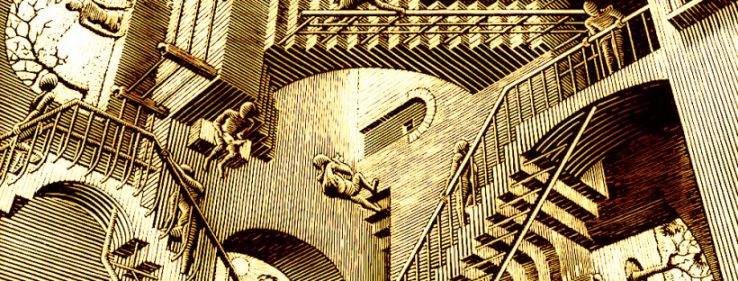The focus of this weeks reading was on the ever present media of HyperText. It permeates our lives and enables usages that people in previous decades could have only dreamed. Of course it would have an effect on literature.
Postmodernism arose in the mid 1900’s and lasted, arguably, until approximately the end of the 20th century, which roughly correlates with the onset of the digital age and the ascendancy of the World Wide Web. In the book Electronic Literacy, by Scott Rettberg, we find that the pioneers of early HyperText literature were deeply rooted in the scholarly analysis of major players in the postmodern literature, such as Thomas Pynchon. Viewing the themes that carried over into their work, notably a willingness to play and subvert established precepts in literature, such as the role of the author, the narrative structure, and the base assumptions inherent to the form of media itself, it is easy to say that those early works of electronic literature were children of postmodern literature.
In particular we can look at Robert Coover’s The Babysitter, an example of postermodern literature that paves the way for later HyperText literature. In The Babysitter, Coover weaves an acid trip of a tale toys with perception, chronology, the reliability of the narrator, and the very expectations we have from a story. Each paragraph long chunk of text is isolated from the rest, visually, by a unique marker, taking the shape of an asterisk amidst a set of quotation marks, that cues the reader in that there is a greater degree of separation than a typical line break that we’d see in other works. Each paragraph seems to be a piece of the story, but stolen from some alternate timeline, jumping from one location to another, one character’s perspective to another, sometimes blending seamlessly between the inner thoughts and realities of a character and other times completely contradicting the events of other paragraphs. The result is a possibility storm, rapid fire imagery of causation stemming from the most minute of decisions. The ludicrous scene of a middle-age woman being shoved back into her butter lubricated-girdle is juxtaposed ironically but poignantly with scenes of rape as clothing is forcibly added in the former and removed in the latter, only to contrasted again with the seemingly innocent act of the babysitter changing the clothes of her wards. The other thus not only connects the story fragments chronologically, but ties them together thematically. This “stream of consciousness” flow between different scenes results in a poetic feel, the sharp transitions allowing for sharp effect, where the story doesn’t always feel literal, but still fraught with meaning.
Of course, all this is done with words on paper. The order of the fragments is stationary, and the reader, even as their brain is racing to piece together the story, is ultimately left in a passive role to be fed what the author gives them and find what meaning they can. What would the story have been like if Coover had made is creation in HyperText? The jumping between different timelines and simultaneous events at multiple locations could lend itself well to the medium, but would the effect be the same? Is the disorientation, the lack of control in the reader essential to the story? What extra level could be attained by adding multi-media, imagery, sound to add to the immersion of the experience? I think these were the sort of questions that drove HyperText authors to carry the same playfulness, the willingness to play with their tools and their medium into the digital age. Postermodernism gave us the permission leave behind traditional norms of literature, to challenge its limitations and create something new, and we’re still just seeing the beginning.
